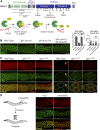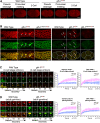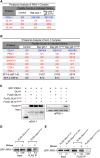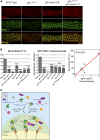The Dynamics of P Granule Liquid Droplets Are Regulated by the Caenorhabditis elegans Germline RNA Helicase GLH-1 via Its ATP Hydrolysis Cycle
- PMID: 32245789
- PMCID: PMC7268986
- DOI: 10.1534/genetics.120.303052
The Dynamics of P Granule Liquid Droplets Are Regulated by the Caenorhabditis elegans Germline RNA Helicase GLH-1 via Its ATP Hydrolysis Cycle
Abstract
P granules are phase-separated liquid droplets that play important roles in the maintenance of germ cell fate in Caenorhabditis elegans Both the localization and formation of P granules are highly dynamic, but mechanisms that regulate such processes remain poorly understood. Here, we show evidence that the VASA-like germline RNA helicase GLH-1 couples distinct steps of its ATPase hydrolysis cycle to control the formation and disassembly of P granules. In addition, we found that the phenylalanine-glycine-glycine repeats in GLH-1 promote its localization at the perinucleus. Proteomic analyses of the GLH-1 complex with a GLH-1 mutation that interferes with P granule disassembly revealed transient interactions of GLH-1 with several Argonautes and RNA-binding proteins. Finally, we found that defects in recruiting the P granule component PRG-1 to perinuclear foci in the adult germline correlate with the fertility defects observed in various GLH-1 mutants. Together, our results highlight the versatile roles of an RNA helicase in controlling the formation of liquid droplets in space and time.
Keywords: ATP hydrolysis; Germ granule; P granule; RNA helicase; VASA; phase separation.
Copyright © 2020 by the Genetics Society of America.
Figures




Similar articles
-
Germline Maintenance Through the Multifaceted Activities of GLH/Vasa in Caenorhabditis elegans P Granules.Genetics. 2019 Nov;213(3):923-939. doi: 10.1534/genetics.119.302670. Epub 2019 Sep 10. Genetics. 2019. PMID: 31506335 Free PMC article.
-
Genetic analysis of the Caenorhabditis elegans GLH family of P-granule proteins.Genetics. 2008 Apr;178(4):1973-87. doi: 10.1534/genetics.107.083469. Genetics. 2008. PMID: 18430929 Free PMC article.
-
P granules extend the nuclear pore complex environment in the C. elegans germ line.J Cell Biol. 2011 Mar 21;192(6):939-48. doi: 10.1083/jcb.201010104. Epub 2011 Mar 14. J Cell Biol. 2011. PMID: 21402789 Free PMC article.
-
The P Granules of C. elegans: A Genetic Model for the Study of RNA-Protein Condensates.J Mol Biol. 2018 Nov 2;430(23):4702-4710. doi: 10.1016/j.jmb.2018.08.007. Epub 2018 Aug 8. J Mol Biol. 2018. PMID: 30096346 Free PMC article. Review.
-
Building RNA-protein germ granules: insights from the multifaceted functions of DEAD-box helicase Vasa/Ddx4 in germline development.Cell Mol Life Sci. 2021 Dec 18;79(1):4. doi: 10.1007/s00018-021-04069-1. Cell Mol Life Sci. 2021. PMID: 34921622 Free PMC article. Review.
Cited by
-
A role for BYN-1/bystin in cellular uptake and clearance of residual bodies in the Caenorhabditis elegans germline.Development. 2024 Oct 1;151(19):dev202694. doi: 10.1242/dev.202694. Epub 2024 Oct 8. Development. 2024. PMID: 39377446
-
Condensate cooperativity underlies transgenerational gene silencing.Cell Rep. 2023 Aug 29;42(8):112859. doi: 10.1016/j.celrep.2023.112859. Epub 2023 Jul 27. Cell Rep. 2023. PMID: 37505984 Free PMC article.
-
Proximity labeling identifies LOTUS domain proteins that promote the formation of perinuclear germ granules in C. elegans.Elife. 2021 Nov 3;10:e72276. doi: 10.7554/eLife.72276. Elife. 2021. PMID: 34730513 Free PMC article.
-
A family of C. elegans VASA homologs control Argonaute pathway specificity and promote transgenerational silencing.Cell Rep. 2022 Sep 6;40(10):111265. doi: 10.1016/j.celrep.2022.111265. Cell Rep. 2022. PMID: 36070689 Free PMC article.
-
piRNAs initiate transcriptional silencing of spermatogenic genes during C. elegans germline development.Dev Cell. 2022 Jan 24;57(2):180-196.e7. doi: 10.1016/j.devcel.2021.11.025. Epub 2021 Dec 17. Dev Cell. 2022. PMID: 34921763 Free PMC article.
References
Publication types
MeSH terms
Substances
Grants and funding
LinkOut - more resources
Full Text Sources

